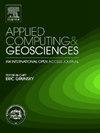Using machine learning classifiers together with discrimination diagrams for validation of rock classification labels
IF 3.2
Q2 COMPUTER SCIENCE, INTERDISCIPLINARY APPLICATIONS
引用次数: 0
Abstract
Rock classification based on chemical components is a common task in the geochemical domain. Literature recommends the Total Alkali and Silica (TAS) discrimination diagram for classifying igneous volcanic rocks by the sum of NaO and KO in relation to SiO contents. This paper comparatively applies the TAS diagram and machine learning classification techniques to a collection of volcanic rocks from the GEOROC database. The study demonstrates a mismatch between the rock type labeled by experts in the database and rock types assigned by the TAS diagram. Despite this discrepancy, the experiments show that support vector machines are particularly promising for building decision systems for rock classification. Random forests, multi-layer perceptrons and K nearest neighbors are less suitable as rock classifiers in the study.
利用机器学习分类器和判别图对岩石分类标签进行验证
基于化学成分的岩石分类是地球化学领域的一项常见任务。文献推荐用总碱硅(Total Alkali and Silica, TAS)判别图,通过Na2O和K2O与SiO2含量的总和对火成岩进行分类。本文将TAS图和机器学习分类技术对比应用于GEOROC数据库中的火山岩集合。该研究表明,数据库中专家标记的岩石类型与TAS图分配的岩石类型之间存在不匹配。尽管存在这种差异,但实验表明,支持向量机在构建岩石分类决策系统方面特别有前途。随机森林、多层感知器和K近邻都不适合作为岩石分类器。
本文章由计算机程序翻译,如有差异,请以英文原文为准。
求助全文
约1分钟内获得全文
求助全文
来源期刊

Applied Computing and Geosciences
Computer Science-General Computer Science
CiteScore
5.50
自引率
0.00%
发文量
23
审稿时长
5 weeks
 求助内容:
求助内容: 应助结果提醒方式:
应助结果提醒方式:


